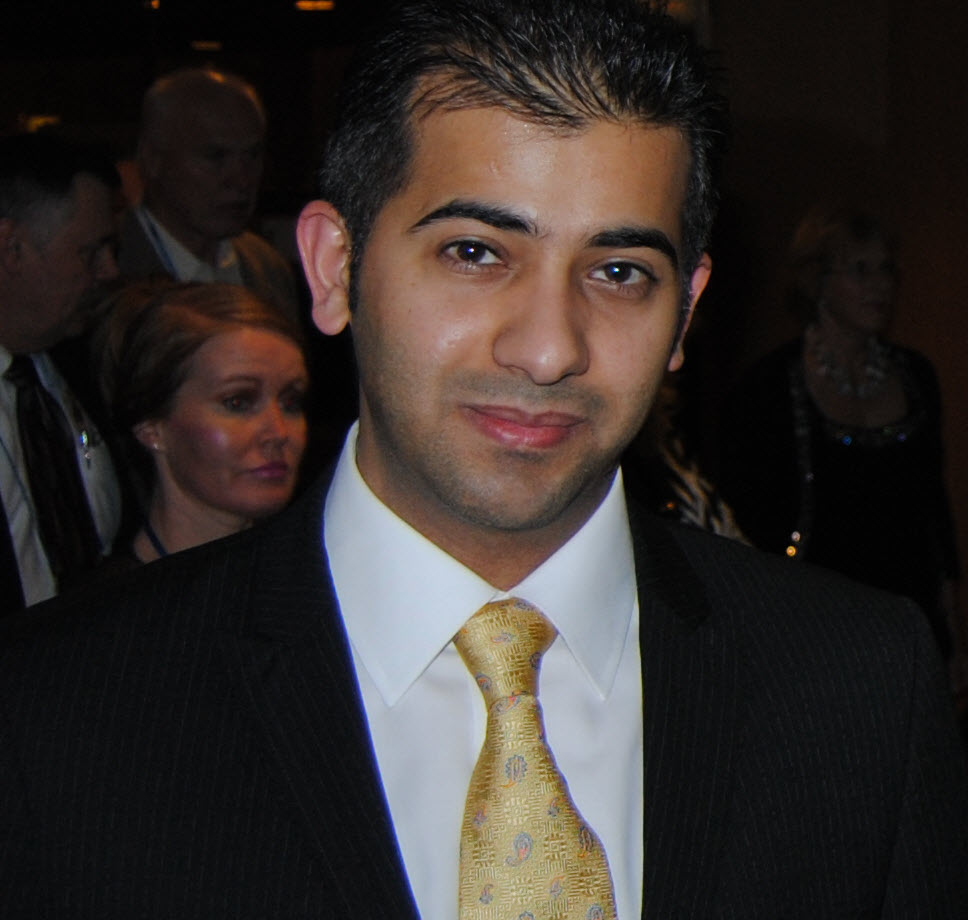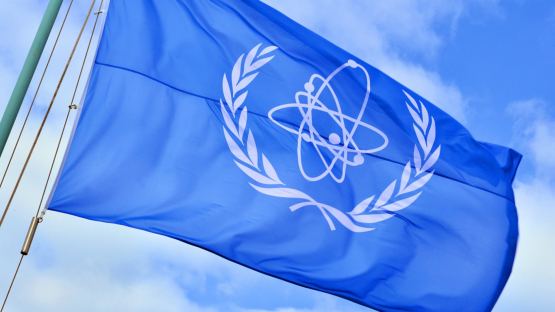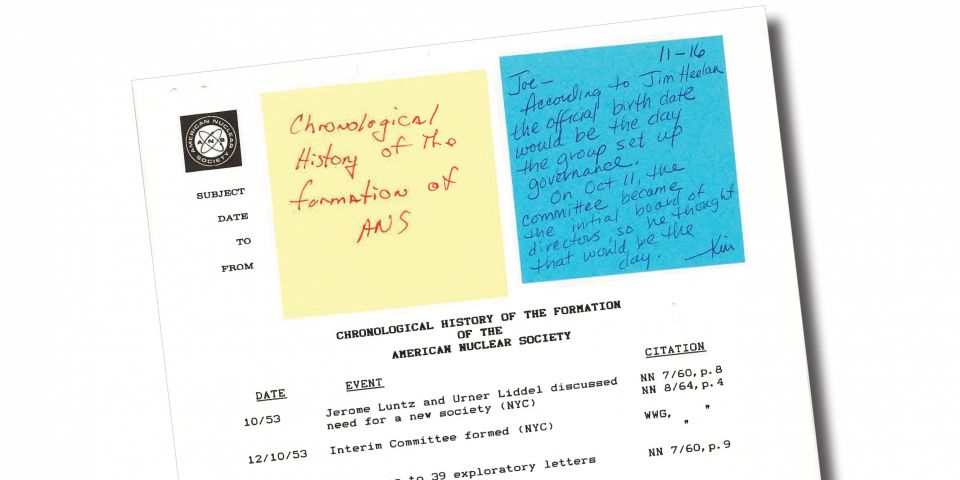UAE Ambassador to IAEA pursues development of nuclear energy
Hamad Al Kaabi is a nuclear engineer
In December 2009, the United Arab Emirates awarded a $20 billion contract to a consortium of South Korean firms to build four nuclear reactors on a remote desert location along the Persian Gulf. The consortium, led by state-owned Korea Electric Power Corp. (KEPCO), is committed to having the first reactor in revenue service by 2017. The change from fossil (natural gas) to uranium as a fuel source comes not a moment too soon as the UAE is now a net importer of gas for electricity generation and desalinization.

UAE Ambassador Hamad Al Kaabi at ANS Winter Meeting, Las Vegas, Nev. (Photo by Fritz Schneider, Clark Communications - 11/09/10)
At the ANS Winter meeting, which took place in Las Vegas, Nev., on November 7-11, I had the opportunity to interview one of the key players in the UAE's nuclear program. Ambassador Hamad Al Kaabi (right) is the UAE Permanent Representative to the International Atomic Energy Agency (IAEA) in Vienna. He has been personally involved in key milestones of the country's nuclear energy assessment, including:
- A national scope energy assessment evaluating future UAE requirements and potential sources of electricity.
- Drafting and release of the policy of the UAE on the evaluation and potential development of nuclear energy.
- National nuclear energy legislation.
- Bilateral agreements related to cooperation in the peaceful uses of nuclear energy between the UAE and various nuclear supplier nations, including France, the United States, the United Kingdom, and the Republic of Korea.
- The UAE pledge of $10 million to support an IAEA-administered international uranium fuel bank initiative, resulting from a proposal by the Nuclear Threat Initiative.
Ambassador Al Kaabi trained as a nuclear engineer, getting his bachelor's and master's degrees from Purdue University in Indiana in the United States. His graduate work focused on nuclear safety.
Background of UAE nuclear deal
In 2006, a UAE energy working group developed projections for electricity needs. It found that demand would expand by three times the current level of use by 2020. The question was how to meet demand.
The UAE evaluated all energy sources including oil, gas, renewables, and nuclear. The working group found that natural gas supplies are not sufficient for future needs. The UAE imports a growing portion of its natural gas supplies. The UAE cannot get more nor produce more since the gas supply is driven by oil production, which is under quota. (see table below)
Natural Gas Supplies
in the United Arab Emirates
Natural Gas Supply Categories | Billions of cubic meters |
| Production | 50.24 |
Consumption | 59.42 |
Imports | 16.75 |
Exports | 7.57 |
Source: CIA World FactBook 2009 data
In addition, the gas has a high sulfur content, which along with burning oil, yields poor environmental performance, and burning oil is a hit on revenues from oil exports. In a nutshell, increased emphasis on fossil fuels had the potential for increased environmental and financial costs that were not acceptable to the UAE.
New technology for desalinization
Desalinization will be supported by nuclear energy. Currently, the UAE is using natural gas to heat seawater and remove fresh water from the process. The UAE will use electricity from the new reactors to run a reverse osmosis plant. While the technology is complicated, recent innovations make it a feasible choice to use on a large scale.
Smaller reverse osmosis units can be placed closer to end users, e.g., factories and cities, thus reducing water pipeline and delivery costs.
"We can make water at night when electricity demand is low," Al Kaabi said.
Solar not the answer to gas use
Despite abundant sunshine, Al Kaabi said that renewable energy sources are not the answer to the challenges of using fossil fuels.
"Even aggressive investment in renewable energy like solar will yield only a small amount of electricity to meet rapidly growing demand. It is not proven that solar can meet base load requirements," Al Kaabi said.
He added that the UAE has had some problems with manufacturing issues regarding solar panels delivered to the UAE and problems with dust from the desert cutting down on the efficiency of solar cells.
Nuclear chosen for reliability and capacity to meet demand
Ultimately, nuclear energy was chosen for the energy path forward because it is a proven, reliable technology that is economically competitive.
The UAE set three broad principles for the path forward for nuclear energy:
- Safety
- Security
- Nonproliferation
The UAE held early consultations with the IAEA to develop a "roadmap" for legislative, institutional, regulatory, and technical organizations. In setting up these organizations, the UAE reviewed best practices globally. Due to the urgency of energy issues, the UAE set 2017 as a target date for start of revenue service for the first reactor.
The next issue was site selection. The UAE chose an uninhabited coastal location on the Persian Gulf. The Braka site is about 50 km (31 miles) from the center of Abu Dhabi's oil industry at Rawis. A port facility will be developed to receive reactor components and construction materials by sea.
The two most important organizations in the UAE new build are the Federal Authority for Nuclear Regulation (FANR), which has 100 employees, and the Emirates Nuclear Energy Corporation (ENEC), which has 300 employees. These employment numbers are expected to grow.
ENEC will manage the construction and operation of the reactors. It will handle all aspects of the supply chain. FANR will handle nuclear safety. A separate government ministry handles security for nuclear facilities.
Another organization is developing a program to educate and certify nuclear engineers in the UAE. The UAE will need them all by 2017.
Of the nation's three million people in the labor force, more than 80 percent are expatriates. The UAE has a goal of educating its own citizens to run the nuclear plants. The reason is that the reactors offer high paying jobs with long-term stability.
Key factors in the contract award
In December 2009, UAE awarded a $20 billion contract to build four 1400 MW PWR type reactors to a consortium from South Korea. Key factors were a buildable design, procurement and construction of components, and lifetime operability. The tender process was completed in a record time of one year.
Al Kaabi said South Korea will provide the first fuel load, but future fuel contracts will be bid as part of the normal procurement process for any nuclear utility.
Training new nuclear engineers and plant personnel was a key success factor for the winning award. The UAE is working hard to promote science technology engineering and math education so that eventually it will have young people entering the nuclear field. Mentoring and certification has a strong emphasis. Until the UAE fully develops its own educational programs, it is sending the first groups of future nuclear engineers to South Korea for training.
1-2-3 agreement with the U.S.
A hallmark of the UAE nuclear program is that it has set as a national policy under which it will not develop uranium enrichment nor spent fuel reprocessing facilities. Because of this policy, a 1-2-3 agreement with the U.S. sailed through Congressional review. It allows U.S. firms to export nuclear technologies to the UAE. The UAE policy is a model for the Middle East. This is the heart of Al Kaabi's message to other countries considering development of nuclear energy.
"No country has done what the UAE has done on enrichment and reprocessing. It is a major milestone in nonproliferation. It is a reflection of UAE policy. We are the first country to achieve such a level of transparency," he said.
"Our experience could be used as a template for other countries," he added. "This approach to nonproliferation is the right way to do things. We hope other countries will see the full international support for our approach and adopt them it as well."
While the ambassador never mentioned Iran directly in his remarks, his comments could be interpreted to include that country. Efforts by the United States and European Union countries to restart negotiations over Iran's uranium enrichment program are off to a rocky start. Meanwhile, the fourth round of sanctions is having an impact on that nation's economy.
The UAE new build is one of the fastest moving nuclear energy programs on the planet after China. Other countries will be following the UAE's progress with interest to take home lessons learned from their experience.
_________________________
Dan Yurman publishes Idaho Samizdat, a blog about nuclear energy. He is a contributing reporter for Fuel Cycle Week and a frequent writer on the ANS Nuclear Cafe.







